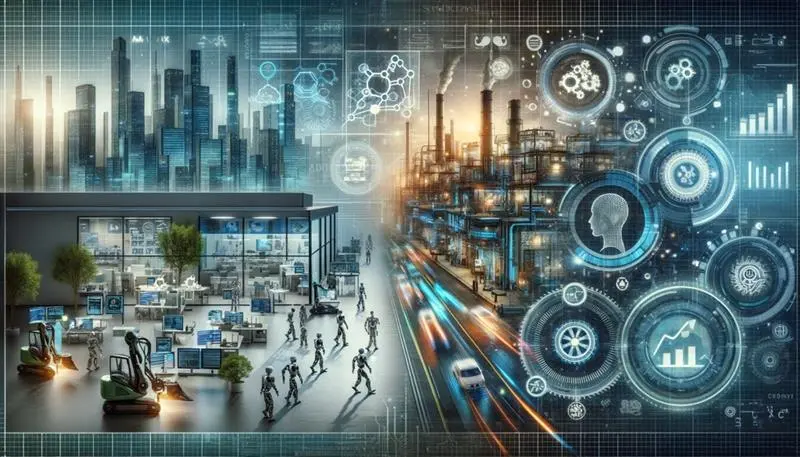“The Only Constant in Life is Change” – Heraclitus”
Automation, often hailed as the cornerstone of modern progress, has become an unstoppable force reshaping the world. Its influence extends beyond mere convenience, altering the very fabric of jobs and human labor. While the focus often centers on whether automation creates or destroys jobs, the deeper, less-discussed reality is that it transforms them in ways we are only beginning to understand.
“Necessity is the Mother of Invention” – Plato”
The Catalyst for Innovation
The Covid-19 pandemic brought an accelerated wave of automation, prompting businesses to adopt cutting-edge technologies at a pace few anticipated. From contactless payment systems to robotic chefs preparing personalized salads, automation proved to be more than just a tool for efficiency. It became a necessity.
For consumers, the shift was a boon: faster services, fewer errors, and reduced costs. For workers, however, the narrative was less straightforward. Automation disrupted traditional roles, creating new opportunities while rendering old ones obsolete. A cab driver, displaced by autonomous vehicles, might find a role as a fleet technician or software specialist—but only if they possess the required skills.
“Education is the Passport to the Future” – Malcolm X”
The Skills Divide
Automation rewards those who adapt, especially workers who can master the specialized skills required to operate alongside it. As Alan Krueger’s research revealed, employees who embrace technological fluency often command wage premiums of 10–15%. Similarly, economic historian James Bessen has credited technological progress for significant wage growth over the centuries.
Yet, this optimistic picture is tempered by automation’s darker side. Daron Acemoglu and Pascual Restrepo highlighted that displaced worker, forced into new roles, often face stiff competition. The influx of displaced clerical workers into retail, for instance, can depress wages as more people vie for fewer jobs.
“The Reward of Suffering is Experience” – Aeschylus”
When Simplicity Lowers Value
Automation doesn’t just displace; it simplifies. And simplicity can erode wages. Consider London’s iconic cab drivers, who once commanded hefty premiums due to their unparalleled knowledge of the city’s labyrinthine streets. With the advent of ride-hailing apps like Uber, this mastery became redundant. Turn-by-turn navigation systems made anyone with a driver’s license a potential cabbie, driving down wages and sparking a torrent of legal battles.
The aviation industry offers another cautionary tale. Early pilots flying dangerous night missions were handsomely rewarded for their specialized skills. As technology advanced—improving navigation systems, engines, and safety protocols—these premiums disappeared. Today, a night flight pays no more than a daytime one.
“What We Obtain Too Cheap, We Esteem Too Lightly” – Thomas Paine”
The Human Cost of Efficiency
While automation boosts productivity, it risks undervaluing human effort. If a machine can replicate a task with near perfection, why pay a premium for human expertise? Yet, this cost-saving mindset overlooks a critical truth: technology is not infallible. Machines fail, algorithms falter, and when they do, it is human ingenuity that steps in.
Consider “Flippy,” the burger-flipping robot that was sidelined after just one day due to its inability to keep pace with customer orders. The solution? Human cooks returned to the kitchen, demonstrating the enduring value of human adaptability and problem-solving.
“The Future Depends on What You Do Today” – Mahatma Gandhi”
Balancing Progress and Prudence
For firms eager to adopt automation, the promise of reduced costs and increased efficiency is alluring. Yet, there are risks. Overreliance on machines without understanding their limitations can backfire. Executives must ask critical questions:
What can’t technology do? While automation excels in routine tasks, it struggles with creativity, empathy, and nuanced decision-making.
How do these limits affect operations? Automation has a productivity ceiling, beyond which diminishing returns set in.
What is the cost of oversight? Monitoring and maintaining automated systems can erode the cost advantages they promise.
More From Author: QueryGPT
“There is No Wealth but Life” – John Ruskin”
A Future of Human-Machine Collaboration
Automation’s true potential lies not in replacing humans but in complementing them. Robots should handle repetitive, hazardous, or dehumanizing tasks, freeing workers to pursue roles that demand creativity, critical thinking, and emotional intelligence. Such a partnership promises a future where efficiency does not come at the cost of humanity.
As Bertrand Russell wisely noted, “Machines have given us the possibility of ease and security for all.” The challenge now is ensuring that this ease benefits everyone—not just the privileged few.
“Do Not Go Where the Path May Lead; Go Instead Where There Is No Path and Leave a Trail” – Ralph Waldo Emerson”
Automation is not an endpoint but a journey—a transformative force that challenges us to adapt, innovate, and rethink the nature of work itself. By embracing change with foresight and caution, we can forge a future where human potential thrives alongside technological progress.


![Izzy Izumi AI Voice Model – Complete Guide for [2025]](https://thenesterblog.com/wp-content/uploads/2025/05/Izzy-Izumi-AI-Voice-Model-300x169.webp)


